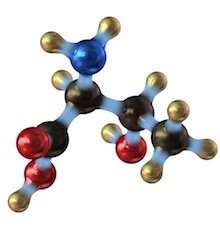Starving leukemia cells by targeting amino acids

Cancer cells consume sugar at a higher rate than healthy cells, but they're also hungry for amino acids, the building blocks of proteins and other biomolecules. Researchers at Winship Cancer Institute of Emory University have discovered a way to exploit that hunger to selectively block the growth of leukemias.
The results were published online Monday, March 11 in Nature Metabolism.
Scientists led by Cheng-Kui Qu, MD, PhD, have identified a transporter enzyme called ASCT2, which brings amino acids into cells, as a target for anticancer drugs. Deleting the gene encoding this enzyme prolongs survival of mice with an aggressive form of leukemia (AML/acute myeloid leukemia): from 45 days to more than 300 days.
"So far, little progress has been made in finding therapeutic targets in amino acid metabolic pathways that can be harnessed to kill cancer cells but spare normal cells," Qu says. "This is a highly promising therapeutic target for leukemia. ASCT2 is dispensable for normal blood cell development, but it is required for leukemia development and progression."
Qu is professor of pediatrics at Emory University School of Medicine, Winship Cancer Institute and Aflac Cancer and Blood Disorders Center, Children's Healthcare of Atlanta. The first author of the paper is postdoctoral fellow Fang Ni, MD, PhD.
Recent years have seen a resurgence of interest in the Warburg effect: the warped metabolism of cancer cells. The idea is to starve tumor cells, while leaving healthy cells alone.
ASCT2 is responsible for taking up several amino acids, such as glutamine, into cells. In leukemia cells, loss of ASCT2 generates a global effect on cellular metabolism, disrupts leucine influx and mTOR signaling, and induces apoptosis.
Qu says his team was surprised to find that the gene encoding ASCT2 can be deleted from mice, without substantially disrupting blood cell development. However, the mice do take longer to recover white blood cell counts after the stress of chemotherapy drugs or radiation.
"Although our overall findings strongly suggest ASCT2 as a therapeutic target for leukemia treatment, researchers will need to exercise caution in combining ASCT2 inhibitors with chemotherapy in clinical trials," Qu says.
Qu's team did test the effectiveness of inhibiting ASCT2 in mice grafted with human AML, and found a significant therapeutic effect, but he says that the drug they used was low in potency and not specific enough for clinical use. Already, other researchers have reported the identification of a specific inhibitor for ASCT2, with activity against other types of cancer as well.
More information: Fang Ni et al. Critical role of ASCT2-mediated amino acid metabolism in promoting leukaemia development and progression, Nature Metabolism (2019). DOI: 10.1038/s42255-019-0039-6




















